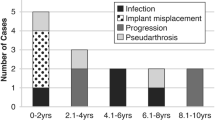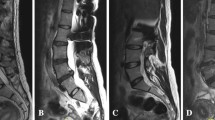Abstract
Introduction
The purpose of the study was to provide a 15-year natural history evaluation of the radiographic appearance of uninstrumented compensatory lumbar curves in patients who had undergone selective thoracic fusion (STF) for scoliosis, measure any changes in health-related quality of life scores (HRQoL) and compare them with controls matched for age, gender and body-mass index (BMI).
Methods
STF group included 43 female adolescent idiopathic scoliosis (AIS) patients who underwent STF with mean age 33(27–42) years and a mean follow-up of 18.7 (15–28) years, mean BMI 22(18–29). Preop, early postop and follow-up radiographs were reviewed for behavior of lumbar curves. Control group included a random selection of healthy volunteers with no history of back pain and with mean age 33(27–41), and mean BMI 22(17–33). HRQoL scores were compared between two groups in latest f/up. Radiographs including low dose biplanar imaging with EOS were used to measure disc heights and assess for radiographic evidence of degenerative changes. Various parameters were statistically compared.
Results
Posterior fusion was performed in all 43, with all pedicle screws used in 41 and all-hook constructs in 2. Main thoracic curve correction was improved from pre-op to early-post-op and maintained at latest f/up (55.6°–16.1°–16.9°). Spontaneous lumbar curve correction (SLCC) was also maintained beyond 15 years (39.9°–16.6°–17.1°). Two patients developed coronal decompensation following surgery, but improved with time and were well compensated at final follow-up. Mean HRQoL scores, self-image and mental health scores were higher in STF group than control group (p < 0.05). SRS-22r pain and function, Oswestry Disability Index and Numeric Rating Scale, marital status, number of children were similar between the groups(p > 0.05). All disc heights except L5-S1 were significantly lower in STF group (p < 0.05). There was no significant difference between the groups for degenerative changes in the latest radiographs.
Conclusion
In this group of patients, the uninstrumented lumbar curve spontaneously corrected and the correction was maintained after 18 years following surgery using STF. Mild degenerative changes were seen radiographically and HRQoL scores suggest that the psychological-functional well-being are quite good in the long term in AIS patients who have undergone STF when compared with an age–gender–BMI-matched population.



Similar content being viewed by others
Abbreviations
- AIS:
-
Adolescent idiopathic scoliosis
- BMI:
-
Body mass index
- HRQoL:
-
Health related quality of life
- NRS:
-
Numeric Rating Scale
- ODI:
-
Oswestry Disability Index
- SLCC:
-
Spontaneous lumbar curve correction
- SRS-22r:
-
Scoliosis Research Society-22r
- STF:
-
Selective thoracic fusion
- SVA:
-
Sagittal vertical axis
References
Dickson JH, Erwin WD, Rossi D (1990) Harrington instrumentation and arthrodesis for idiopathic scoliosis. A twenty-one-year follow-up. J Bone Joint Surg Am 72:678–183
Danielsson AJ, Nachemson AL (2003) Back pain and function 23 years after fusion for adolescent idiopathic scoliosis: a case-control studydpart II. Spine (Phila Pa 1976) 28:373-83.
Helenius I, Remes V, Lamberg T et al (2008) Long-term health-related quality of life after surgery for adolescent idiopathic scoliosis and spondylolisthesis. J Bone Joint Surg Am 90:1231–1239
Takayama K, Nakamura H, Matsuda H (2009) Low back pain in patients treated surgically for scoliosis: longer than sixteen-year follow-up. Spine (Phila Pa 1976) 34:2198–204
Enercan M, Kahraman S, Cobanoglu M, Yilar S, GokcenBH, Karadereler S, Mutlu A, Ulusoy LO, Ozturk C, Erturer E, Gebes E, Sanli T, Alanay A, Hamzaoglu A (2015) Selective thoracic fusion provides similar health-related quality of life but can cause more lumbar disc and facet joint degeneration: a comparison of adolescent idiopathic scoliosis patients with normal population 10 years after surgery. Spine Deform 3:469–475
Louer C Jr, Yaszay B, Cross M et al (2019) Ten-year outcomes of selective fusions for adolescent idiopathic scoliosis. JBJS 101(9):761–770
King HA, Moe JH, Bradford DS, Winter RB (1983) The selection of fusion levels in thoracic idiopathic scoliosis. J Bone Joint Surg Am 65:1302–1313
Bridwell K, McAllister J, Betz R et al (1991) Coronal decompensation produced by Cotrel Dubousset ‘derotation’ maneuver for idiopathic right thoracic scoliosis. Spine 16:769–777
Lenke L, Bridwell K, Baldus C et al (1992) Preventing decompensation in KingType II curves treated with Cotrel-Dubousset instrumentation: strict guidelines for selective fusion. Spine 17S:274–281
Fischer CR, Kim Y (2011) Selective fusion for adolescent idiopathic scoliosis: a review of current operative strategy. Eur Spine J 20(7):1048–1057
Edwards 2nd CC, Lenke LG, Peelle M, et al. (2004) Selective thoracic fusion for adolescent idiopathic scoliosis with C modifier lumbar curves: 2- to 16-year radiographic and clinical results. Spine (Phila Pa 1976) 29:536–46
Lenke LG, Edwards 2nd CC, BridwellKH (2003) The Lenke classification of adolescent idiopathic scoliosis: how it organizes curve patterns as a template to perform selective fusions of the spine. Spine (Phila Pa 1976) 28:199–207
Chang MS, BridwellKH, Lenke LG, et al (2010) Predicting the outcome of selective thoracic fusion in false double major lumbar ‘‘C’’ cases with 5- to 24-year followup. Spine (Phila Pa 1976) 35: 2128–33.
Chang KW, Leng X, Zhao W, et al (2011) Broader curve criteria for selective thoracic fusion. Spine (Phila Pa 1976) 36: 1658–64.
Qiu G, Zhang J, Wang Y, et al (2005) A new operative classification of idiopathic scoliosis: a Peking Union Medical College method. Spine( Phila Pa 1976) 30: 1419–26
Schulz J, Asghar J, Bastrom T, Shufflebarger H, Newton PO, Sturm P, Betz RR, Samdani AF, Yaszay B, Harms Study Group (2014) Optimal radiographical criteria after selective thoracic fusion for patients with adolescent idiopathic scoliosis with a C lumbar modifier. Does adherence to current guidelines predict success? Spine (Phila Pa 1976) 39:E1368–73.
Larson AN, Fletcher ND, Daniel C, Richards BS (2012) Lumbar curve is stable after selective thoracic fusion for adolescent idiopathic scoliosis: a 20-year follow-up. Spine (Phila Pa 1976) 37:833-9.
Grivas TB (2014) Rib index. Scoliosis 9:20. https://doi.org/10.1186/s13013-014-0020-9
Lonstein JE (2018) Selective thoracic fusion for adolescent idiopathic scoliosis: long-term radiographic and functional outcomes. Spine Deform 6(6):669–675
Funding
No funding was received for this work.
Author information
Authors and Affiliations
Corresponding author
Ethics declarations
Conflict of interest
Azmi Hamzaoglu is a consultant of Medtronics. The other authors declare that they have no other conflict of interest.
Ethical Approval
All procedures performed in studies involving human participants were in accordance with the ethical standards of the institutional and/or national research committee and with the 1964 Helsinki declaration and its later amendments or comparable ethical standards.
Additional information
Publisher's Note
Springer Nature remains neutral with regard to jurisdictional claims in published maps and institutional affiliations.
Rights and permissions
About this article
Cite this article
Hamzaoglu, A., Karadereler, S., Kahraman, S. et al. Clinical, radiological and HRQoL outcomes after selective thoracic fusion with minimum 15-year follow-up. Spine Deform 9, 1323–1331 (2021). https://doi.org/10.1007/s43390-021-00350-2
Received:
Accepted:
Published:
Issue Date:
DOI: https://doi.org/10.1007/s43390-021-00350-2




